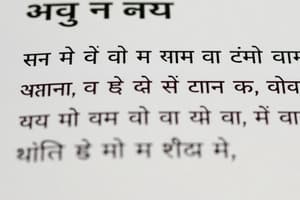Podcast
Questions and Answers
To which language family does Sanskrit belong?
To which language family does Sanskrit belong?
- Sino-Tibetan
- Indo-European (correct)
- Dravidian
- Austroasiatic
In which geographical region did Sanskrit originate?
In which geographical region did Sanskrit originate?
- Central Asia
- Southeast Asia
- East Asia
- South Asia (correct)
Which of the following is the oldest form of Sanskrit?
Which of the following is the oldest form of Sanskrit?
- Apabhramsa
- Classical Sanskrit
- Pali
- Vedic Sanskrit (correct)
Who standardized Classical Sanskrit grammar?
Who standardized Classical Sanskrit grammar?
Which term describes a language where grammatical relationships are shown through changes in word forms?
Which term describes a language where grammatical relationships are shown through changes in word forms?
How many genders does Sanskrit grammar recognize for nouns?
How many genders does Sanskrit grammar recognize for nouns?
Which of these is a major feature of Sanskrit phonology, involving sound changes at word boundaries?
Which of these is a major feature of Sanskrit phonology, involving sound changes at word boundaries?
Which of the following Vedas is a collection of hymns?
Which of the following Vedas is a collection of hymns?
Which of the following is a type of text found in classical Sanskrit literature?
Which of the following is a type of text found in classical Sanskrit literature?
Which field is NOT a topic of Sanskrit scientific and technical texts?
Which field is NOT a topic of Sanskrit scientific and technical texts?
Which of these languages has been significantly influenced by Sanskrit?
Which of these languages has been significantly influenced by Sanskrit?
Which of the following concepts does the Bhagavad Gita primarily contain?
Which of the following concepts does the Bhagavad Gita primarily contain?
What aspect of nouns does case endings indicate in Sanskrit grammar?
What aspect of nouns does case endings indicate in Sanskrit grammar?
Which of the following is a characteristic of Sanskrit word order?
Which of the following is a characteristic of Sanskrit word order?
What does 'samasa' refer to in Sanskrit grammar?
What does 'samasa' refer to in Sanskrit grammar?
What is indicated by verb conjugations in Sanskrit
What is indicated by verb conjugations in Sanskrit
Which of the following describes 'visarga' ( ḥ )?
Which of the following describes 'visarga' ( ḥ )?
In which religion is Sanskrit a primary liturgical language?
In which religion is Sanskrit a primary liturgical language?
What is the role of Sanskrit in Buddhism?
What is the role of Sanskrit in Buddhism?
What is the current status of Sanskrit?
What is the current status of Sanskrit?
On which languages did Sanskrit have a significant impact?
On which languages did Sanskrit have a significant impact?
Approximately how many sutras (rules) are contained in Pāṇini's Ashtadhyayi?
Approximately how many sutras (rules) are contained in Pāṇini's Ashtadhyayi?
Flashcards
What is Sanskrit?
What is Sanskrit?
A classical Indo-European language of South Asia, important in Hinduism, Buddhism, and Jainism.
What is Vedic Sanskrit?
What is Vedic Sanskrit?
The earliest form of Sanskrit, found in ancient hymns.
What is Classical Sanskrit?
What is Classical Sanskrit?
Standardized by Pāṇini, it became the main literary language of ancient India.
What is inflection?
What is inflection?
Signup and view all the flashcards
What are the three genders in Sanskrit?
What are the three genders in Sanskrit?
Signup and view all the flashcards
What are the three numbers in Sanskrit?
What are the three numbers in Sanskrit?
Signup and view all the flashcards
What is Sandhi?
What is Sandhi?
Signup and view all the flashcards
What are the Vedas?
What are the Vedas?
Signup and view all the flashcards
Classical Sanskrit Literature
Classical Sanskrit Literature
Signup and view all the flashcards
Languages Influenced by Sanskrit
Languages Influenced by Sanskrit
Signup and view all the flashcards
Key Sanskrit Texts
Key Sanskrit Texts
Signup and view all the flashcards
Word Order in Sanskrit
Word Order in Sanskrit
Signup and view all the flashcards
Case Endings
Case Endings
Signup and view all the flashcards
Compound Words (Samasa)
Compound Words (Samasa)
Signup and view all the flashcards
Sandhi Rules
Sandhi Rules
Signup and view all the flashcards
Sanskrit's Role in Hinduism
Sanskrit's Role in Hinduism
Signup and view all the flashcards
Reviving Sanskrit
Reviving Sanskrit
Signup and view all the flashcards
Sanskrit's Linguistic Influence
Sanskrit's Linguistic Influence
Signup and view all the flashcards
Pāṇini
Pāṇini
Signup and view all the flashcards
Ashtadhyayi
Ashtadhyayi
Signup and view all the flashcards
Sandhi
Sandhi
Signup and view all the flashcards
Samasa
Samasa
Signup and view all the flashcards
Karaka
Karaka
Signup and view all the flashcards
Study Notes
- Sanskrit is a classical language of South Asia belonging to the Indo-Aryan branch of the Indo-European languages.
- It arose in South Asia after predecessor languages diffused from the northwest during the late Bronze Age.
- Sanskrit is among the oldest attested Indo-European languages.
- It's highly significant in Hinduism, Buddhism, and Jainism.
- Sanskrit is a liturgical language in these religions as well as a philosophical language.
History and Development
- Vedic Sanskrit, the earliest attested form, is found in the Rigveda, dating to the second millennium BCE.
- The Rigveda stands as one of the oldest texts in any Indo-European language.
- Vedic Sanskrit evolved into Classical Sanskrit, standardized by Pāṇini in the 4th century BCE.
- Pāṇini's grammar, the Ashtadhyayi, defined Sanskrit rules with precision.
- Classical Sanskrit became ancient India's primary literary language.
Linguistic Features
- Sanskrit is highly inflected; grammatical relationships are shown through word form changes.
- Nouns, pronouns, adjectives, and verbs have different forms based on grammatical function.
- Sanskrit features three genders (masculine, feminine, neuter), three numbers (singular, dual, plural), and eight cases (nominative, accusative, instrumental, dative, ablative, genitive, locative, vocative).
- Verbs are conjugated for tense, mood, voice, number, and person.
- Sanskrit phonology has a rich inventory of sounds, including aspirated/unaspirated stops and retroflex consonants.
- Sandhi, or phonetic combination, changes sounds at the end of a word based on the beginning sound of the next.
Literature
- Sanskrit literature is vast and diverse, covering many genres and subjects.
- The Vedas (Rigveda, Samaveda, Yajurveda, Atharvaveda) are among Sanskrit's oldest and most important texts.
- The Upanishads, philosophical treatises exploring reality and the self, are highly influential.
- The Ramayana and Mahabharata epics are central to Indian culture and mythology.
- The Puranas are encyclopedic texts covering mythology, cosmology, history, and religious practices.
- Classical Sanskrit literature includes drama, poetry, and prose by authors like Kalidasa, Bhasa, and Bana.
- Sanskrit was used for scientific and technical texts on astronomy, mathematics, medicine, and grammar.
Influence and Legacy
- Sanskrit has profoundly influenced languages like Hindi, Bengali, Marathi, and Nepali.
- Many words in these languages are derived from Sanskrit roots.
- English and other European languages have Sanskrit-derived words like "karma," "yoga," and "avatar."
- Sanskrit continues to be studied and used globally.
- It's taught in universities and used in religious rituals, research, and creative writing.
- Sanskrit is being revived as a spoken language, with communities using it in daily life.
Key Texts
- Rigveda: A collection of Vedic Sanskrit hymns.
- Ashtadhyayi: Pāṇini's grammar and a foundational text.
- Ramayana: An epic poem attributed to Valmiki.
- Mahabharata: An epic poem attributed to Vyasa.
- Bhagavad Gita: From the Mahabharata, containing philosophical teachings.
- Upanishads: Philosophical treatises on the nature of reality.
- Puranas: Encyclopedic texts covering mythology, history, and cosmology.
- Works of Kalidasa, including Shakuntala and Meghaduta.
- Sanskrit scientific texts cover astronomy, mathematics, and medicine.
Grammatical Structure
- Sanskrit grammar, codified by Pāṇini, is highly structured.
- Word arrangement in sentences is relatively free compared to English.
- Word order is often stylistic, determined by emphasis.
- Case endings on nouns indicate their grammatical function.
- Verb conjugations indicate tense, mood, person, and number.
- Compound words (samasa) are common.
- Sandhi rules govern phonetic changes when words combine.
Phonology
- Sanskrit has a complex phonological system.
- Vowels include short and long versions of a, i, u, r̥, and l̥, plus diphthongs like e, ai, o, and au.
- Consonants are classified by place and manner of articulation (stops, nasals, fricatives, approximants).
- Aspirated consonants (kh, gh, ch, jh, th, dh, ph, bh) are distinguished from unaspirated consonants (k, g, c, j, t, d, p, b).
- Retroflex consonants (ṭ, ṭh, ḍ, ḍh, ṇ, ṣ) are produced with the tongue curled back.
- Visarga (ḥ) is a voiceless post-glottal fricative at the end of words.
- Anusvara (ṃ) represents a nasal sound and can occur at the beginning, middle, or end of a word.
Religious Significance
- Sanskrit is the primary liturgical language of Hinduism.
- Mantras, hymns, and prayers are recited in Sanskrit during religious ceremonies.
- Many Hindu scriptures, including the Vedas, Upanishads, and Puranas, are in Sanskrit.
- Sanskrit is important in Buddhism, especially in Mahayana and Vajrayana traditions.
- Many Buddhist sutras and tantras are written in Sanskrit or have Sanskrit versions.
- In Jainism, Sanskrit is used in some prayers and rituals, and many Jain scriptures have Sanskrit commentaries.
- Sanskrit use is believed to invoke spiritual power and connect devotees to the divine.
Modern Usage
- Sanskrit isn't widely spoken as a first language, but revival efforts are underway.
- It's taught in many schools and universities in India and worldwide.
- Organizations and communities promote Sanskrit in daily life.
- Sanskrit appears in contemporary literature, music, and art.
- Some scholars use Sanskrit for academic writing and discussion.
- The Indian government supports Sanskrit study and promotion.
- Sanskrit remains an important aspect of India's cultural and intellectual heritage.
Influence on Other Languages
- Sanskrit has significantly impacted the vocabulary and grammar of languages in South Asia and beyond.
- Modern Indo-Aryan languages like Hindi, Bengali, Marathi, and Gujarati derive from or borrow from Sanskrit.
- Dravidian languages like Tamil, Telugu, Kannada, and Malayalam have been influenced by Sanskrit vocabulary.
- Sanskrit has contributed loanwords to English and other European languages.
- The study of Sanskrit has aided the development of comparative linguistics and Indo-European studies.
- Discovering Sanskrit's relationship to Greek and Latin was key in reconstructing Proto-Indo-European.
Pāṇini's Grammar
- Pāṇini was an ancient Indian grammarian from the 4th century BCE.
- His grammar, the Ashtadhyayi, is a systematic treatment of Sanskrit grammar.
- The Ashtadhyayi comprises approximately 4,000 sutras (rules) describing Sanskrit phonology, morphology, and syntax.
- Pāṇini's grammar is valued for its precision and completeness.
- It's considered a major intellectual achievement in linguistics.
- The Ashtadhyayi has been studied for generations and remains influential.
- Pāṇini's work has influenced computer science and formal language theory.
Key Concepts in Sanskrit Grammar
- Sandhi: Phonetic combination at word boundaries.
- Samasa: Compound word formation.
- Karaka: Grammatical case roles defining relationships between nouns and verbs.
- Tense and Aspect: Categories indicating time and duration of actions.
- Mood: Grammatical category revealing the speaker's attitude.
- Voice: Grammatical category for whether the subject acts or receives the action.
- Derivation: Forming new words from existing ones.
- Declension: Inflection of nouns, pronouns, and adjectives.
- Conjugation: Verb inflection.
Studying That Suits You
Use AI to generate personalized quizzes and flashcards to suit your learning preferences.




